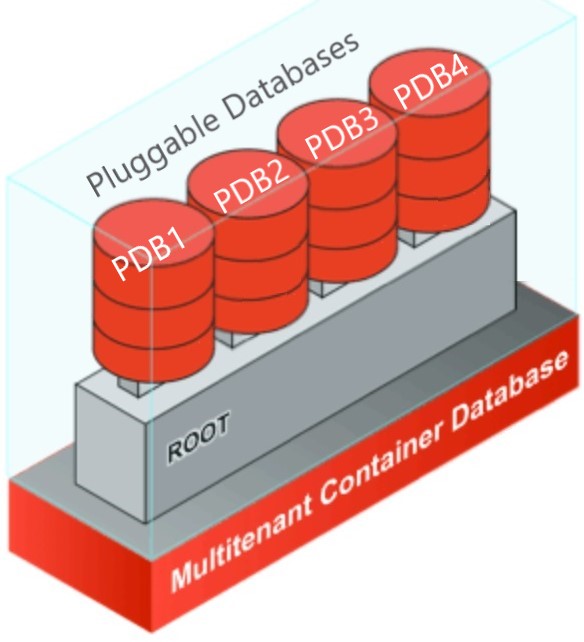Multitenant Architecture
The MODS 'Database As A Service' solution relies on the Oracle Multitenant architecture which brings about the following advantages:
- Consolidation
- Isolation
- Scalability
- Agility
- Cost-efficiency
Pluggable Databases PDB
The PDB is a self-contained, fully functional Oracle Database, for a specific application. The customer can order a PDB through the ESC portal and get it within minutes. The same applies for the deprovisioning. Then the customer gets the complete administration privilege (DBA role) on his PDB.
Container Database CDB

The Container Database can host a large number of PDBs and is therefore the enveloppe used for consolidation and the base for scalability. The CDB is owned by a customer. The CDB is managed and administered by the MODS team.
Consolidation and Cost-Efficiency
It is up to the customer to define the best consolidation strategy (for example depending upon the company's Departments or the Life Cycle stages).
Consolidation also has many advantages in terms of administration and technical efficiency as many database operations need only be done at CDB level, such as:
- Backup
- Instance administration (shared memory and background processes)
- Patching, Upgrade
Besides, the following high availability features are configured at the CDB level and therefore provide their benefits to all PDBS contained therein, all at once:
- Real Application Clusters (RAC) with 2 nodes for high availability
- Data Guard for replication to a standby database
The above translates as cost-efficiency for the customer both in terms of capital expenses and operating expenses
The CDB is ordered by the customer with some key information:
- Number of vcpus to be allocated
- Database version (currently, the customer has the choice between the Oracle Enterprise Edition in versions 12.2 and 19c)
- Plan (Standard or Advanced)
- Standard: RAC database
- Advanced: RAC database + Data Guard standby database
- With or without backup
- Lockdown profile (will be applicable to all PDBs within)
- License scheme
PDB Isolation
Isolation from a Security perspective
Though a PDB is intrisically isolated from the other PDBs, several additional security measures make sure that the Pluggable Databases are fully isolated from one another:
- PDB Lockdown Profiles
- PDB 'PATH_PREFIX' database property and 'db_create_file_dest' parameter set at PDB level
- 'pdb_os_credential' parameter set at PDB level
Isolation from a Resource Management perspective
With the concept of consolidation comes the need for a solution of resource management. At MODS, the solution implemented is based on 'shares' of resources. The customer can choose a resource management profile amont the following:
- HIGH (3 shares)
- MEDIUM (2 shares)
- LOW (1 share)
A PDB resource management profile can be chosen and applied at the time of PDB creation. It can also be modified later, as a Day 2 Action.
Agility
The customer has the agility to:
- Provision / Unprovision PDBs very fast
- Operate transfers between PDBs through Data Pump
- Request restore of a PDB to a specific point-in-time (PIT)
It is now even possible to make PDB snap clones instantly from a PDB master. This feature can prove to be tremendously efficient for development and testing purposes, with the added advantage of saving costs.
